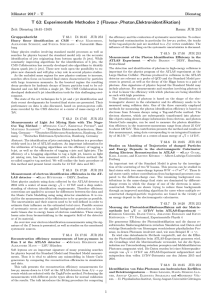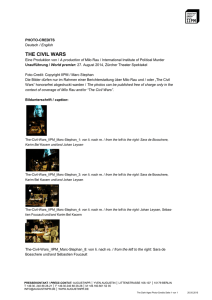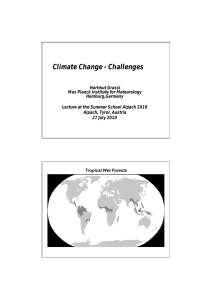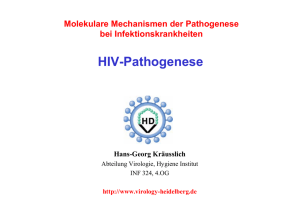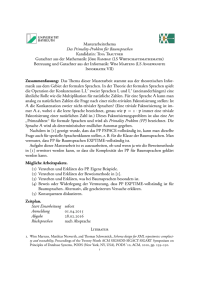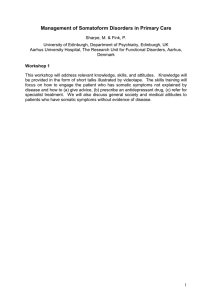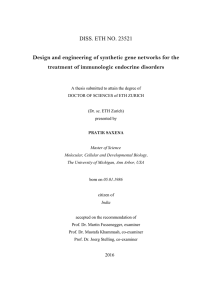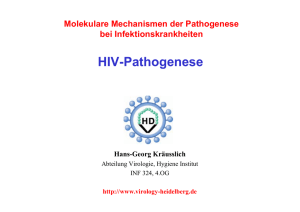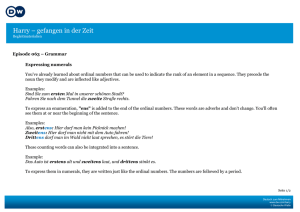Caveolae-mediated endocytosis of Simian Virus 40 - ETH E
Werbung
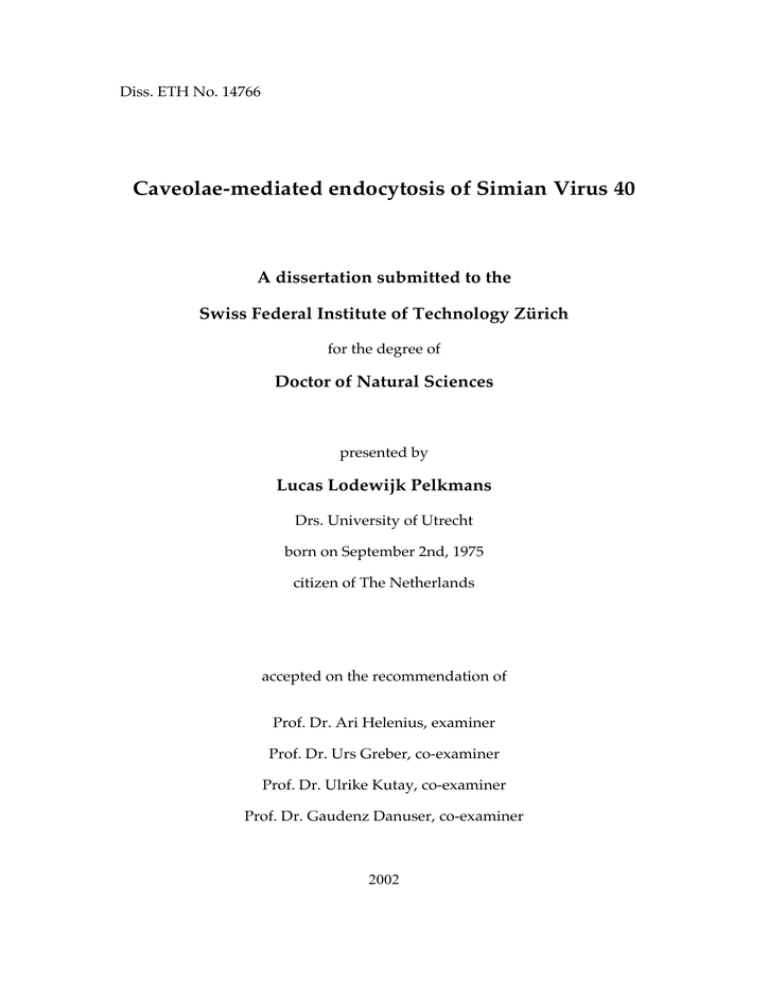
Diss. ETH No. 14766 Caveolae-mediated endocytosis of Simian Virus 40 A dissertation submitted to the Swiss Federal Institute of Technology Zürich for the degree of Doctor of Natural Sciences presented by Lucas Lodewijk Pelkmans Drs. University of Utrecht born on September 2nd, 1975 citizen of The Netherlands accepted on the recommendation of Prof. Dr. Ari Helenius, examiner Prof. Dr. Urs Greber, co-examiner Prof. Dr. Ulrike Kutay, co-examiner Prof. Dr. Gaudenz Danuser, co-examiner 2002 vi Caveolae-mediated endocytosis of SV40 Zusammenfassung Endozytose ist ein essentieller zellulärer Prozess, der die Erhaltung der zellulären Homeostase, die Aufnahme von Nährstoffen und die Abwehr von Mikroorganismen ermöglicht. Von den verschiedenen bekannten Formen der Endozytose sind die Prozesse der Phagozytose und der Clathrin-vermittelten Endozytose auf molekularer Ebene detailliert charakterisiert. Im Gegensatz dazu weiss man sehr wenig über andere Arten der Endozytose. Da viele Krankheitserreger, unter ihnen auch Viren, die verschiedenen Endozytosewege für ihren Eintritt in die Zelle ausnutzen, stellen sie exzellente Hilfsmittel zur Erforschung dieser Prozesse dar. Simian Virus 40, ein doppelsträngiges DNA Virus der Papova Virusfamilie, dessen nur ansatzweise beschriebener Aufnahmeweg von Caveolae an der Zelloberfläche zum glatten endoplasmatischen Retikulum führt, wurde hier benutzt, um diese Form der Endozytose detaillierter zu charakterisieren. Die Analyse des Viruseintritts in lebenden Zellen zeigte, dass internalisierte Caveolae sich zuerst in einem neuen, intrazellulären Kompartiment ansammeln, welches Caveosom genannt wurde. Caveosomen konnten als prä-existierende Organellen definiert werden, die reich an Caveolin-1 und einigen ,,lipid-raft’’-Bestandteilen waren und einen neutralen pH aufwiesen, während sie frei waren von Markern des biosynthetischen und des klassischen Endozytosewegs. Von Caveosomen aus wurden die Viruspartikel in tubuläre Strukturen sortiert, die kein Caveolin-1 mehr aufwiesen, und entlang von Mikrotubuli zum glatten endoplasmatischen Retikulum transportiert. Untersuchungen der frühen Aufnahmestadien zeigten, dass die Viruspartikel nach ihrer Bindung in Caveolae eine vorübergehende Depolymerisierung von Aktin Stressfasern induzierten. Aktin wurde an virusbeladene Caveolae rekrutiert, wo es zu kleinen Plattformen organisiert wurde, an denen dann Aktin „Schweife“ gebildet wurden. Dynamin2 wurde ebenfalls vorübergehend an virusbeladene Caveolae rekrutiert. Diese virus-induzierten Ereignisse waren abhängig von Cholesterin, sowie von der Aktivierung von Tyrosinkinasen zur Phosphorylierung von CaveolaeProteinen. Nur so war die Abschnürung endozytotischer Vesikel aus Caveolae und deren Transport zu Caveosomen, sowie eine virale Infektion möglich. Zusammengefasst ist Endozytose von Caveolae ein Ligand-vermittelter Prozess, welcher eine weitreichende Reorganisation des Aktin Zytoskeletts beinhaltet und einen neuartigen zweistufigen Transportweg von der Plasmamembran über Caveosomen zum endoplasmatischen Retikulum beschreibt. Der Aufnahmeweg umgeht Endosomen und Golgi-Apparat und ist Teil der infektiösen Route von SV40. Summary vii Summary Endocytosis is an essential cellular process that allows the maintenance of cellular homeostasis, the uptake of nutrients and other substances, the transduction of intraand intercellular signals and an effective defense against microorganisms. Endocytosis occurs in many different forms. Of these, the processes of phagocytosis and clathrin-mediated endocytosis have been characterized in molecular detail. Little is known about other types of endocytosis. Since many pathogens, including animal viruses, have evolved ways to exploit different endocytic pathways in order to gain entry into the host cell, they provide excellent tools to study endocytosis. Simian Virus 40 (SV40), a double stranded DNA virus of the papova virus family, utilizes a poorly characterized uptake pathway via cell surface caveolae to the smooth endoplasmic reticulum (ER). It was used in this thesis as a tool to characterize this clathrin-independent endocytic pathway in more detail. Following the entry of virus particles in living cells, it was found that the virus induces the internalization of caveolae, and that the internalized caveolae deliver their cargo to a previously unknown intracellular organelle that was termed the caveosome. Caveosomes were found to be pre-existing, enriched in caveolin-1 and several other lipid-raft constituents and to contain a neutral pH. They were devoid of markers from the classical endocytic pathway or biosynthetic compartments. From caveosomes, virus particles were sorted into tubular carriers lacking caveolin-1 that were transported along microtubules to the smooth endoplasmic reticulum. Studies of the early stages of uptake showed that after binding to caveolae, the virus particles induced a transient breakdown of actin stress fibers. Actin was recruited to the virus-loaded caveolae as small actin patches that served as sites for the formation of actin ‘tails’. Dynamin2 was also transiently recruited to virus-loaded caveolae. These virus-triggered events depended on the presence of cholesterol and on the activation of tyrosine kinases that phosphorylated proteins in caveolae. They were necessary for formation of caveolae-derived endocytic vesicles and their transport to caveosomes, as well as for virus infection. Taken together, caveolar endocytosis is a ligand-triggered event that involves extensive rearrangement of the actin cytoskeleton. It defines a new, two-step transport pathway from plasma membrane caveolae, via caveosomes to the endoplasmic reticulum. The pathway by-passes endosomes and the Golgi complex, and is part of the productive infectious route used by SV40.


